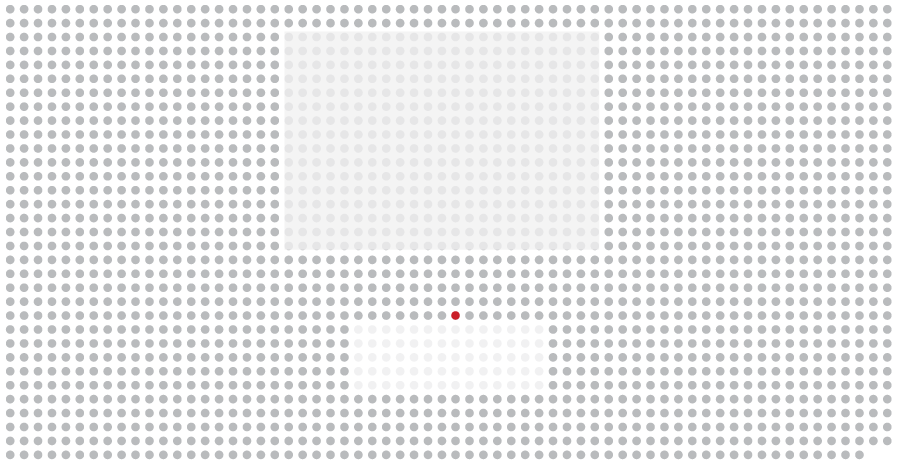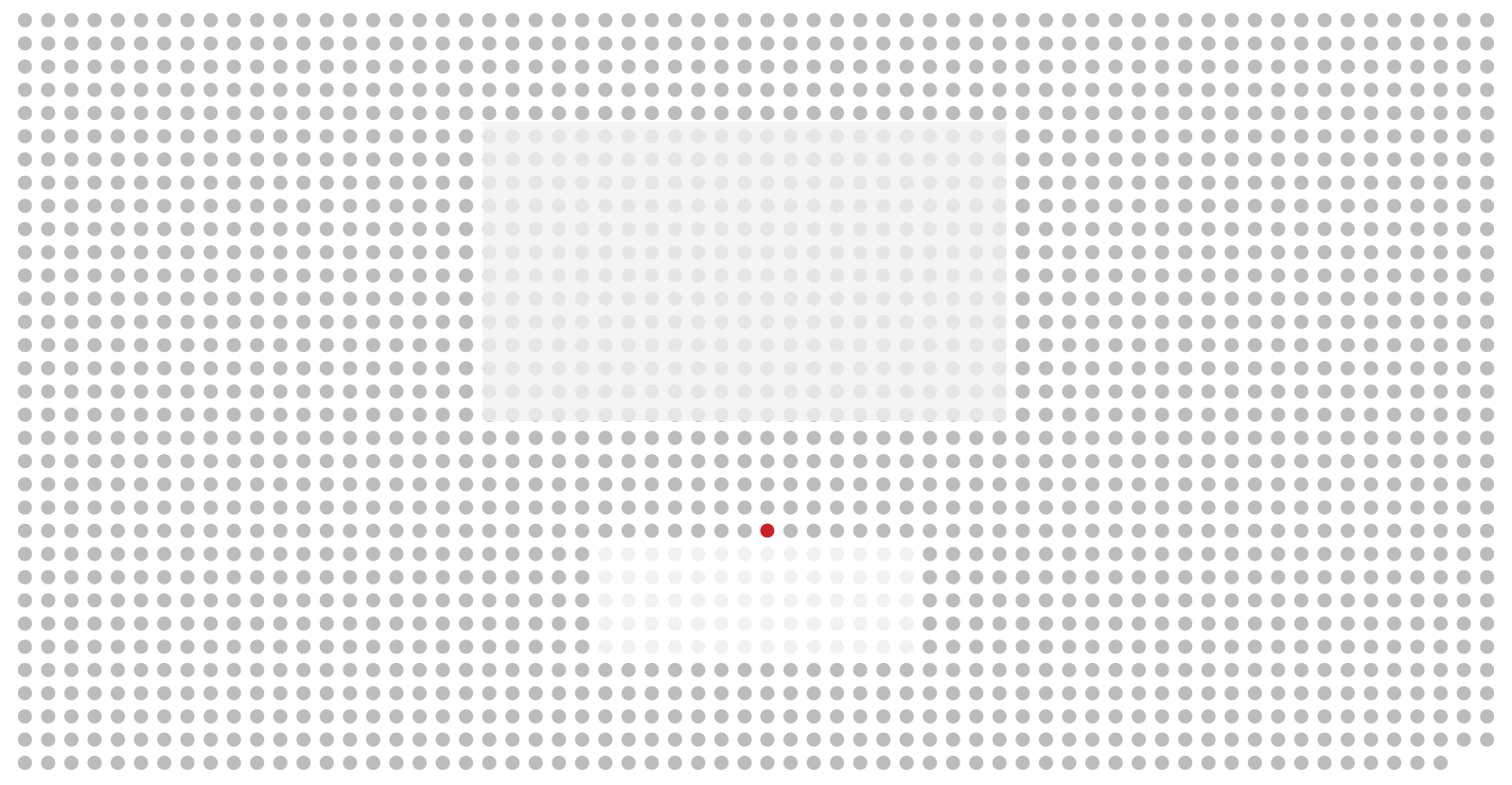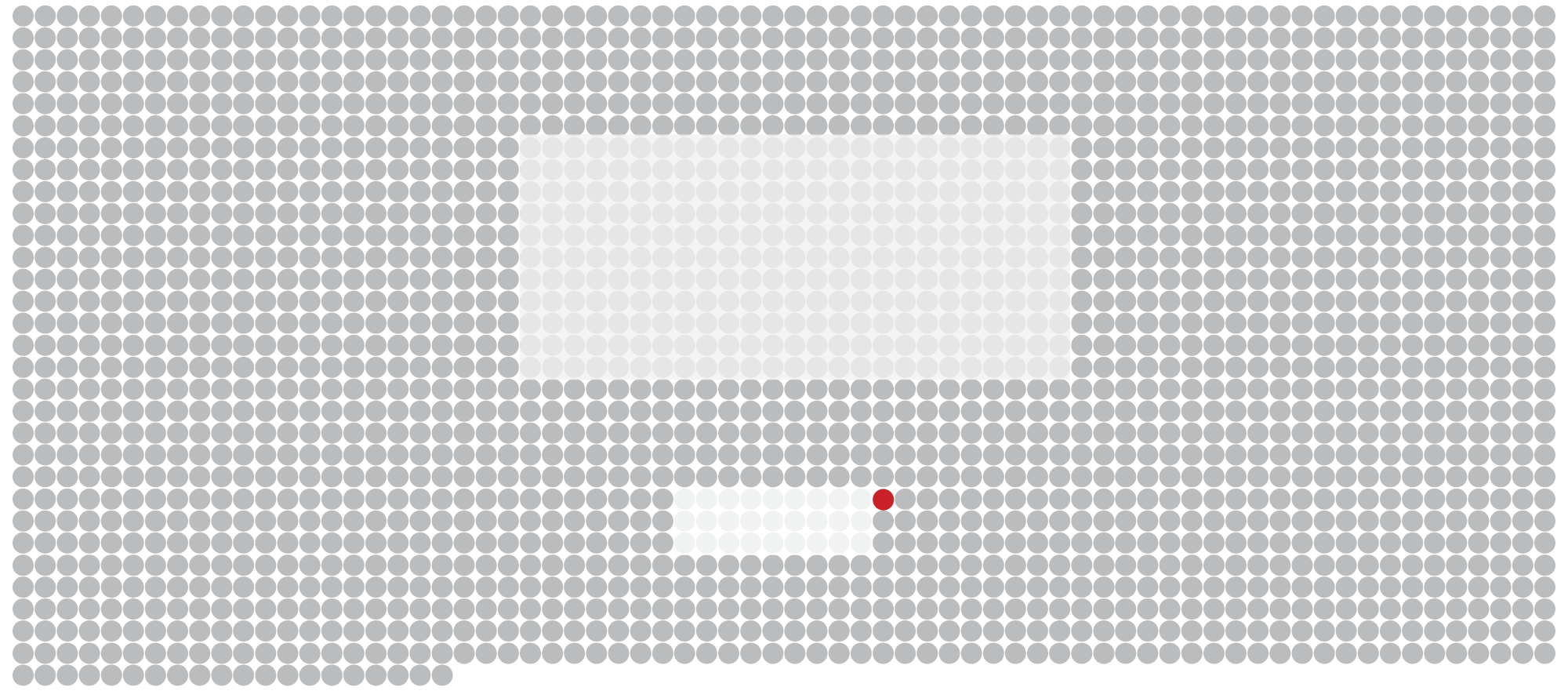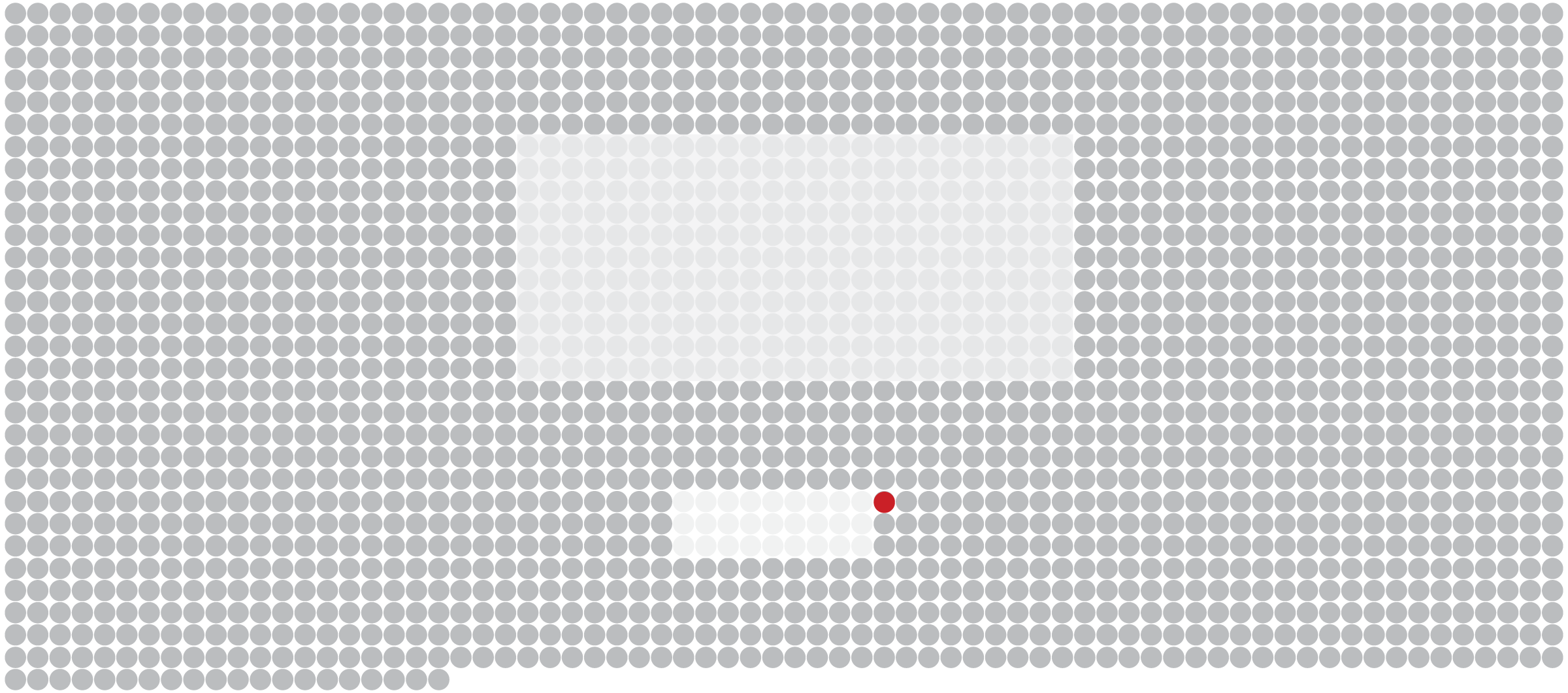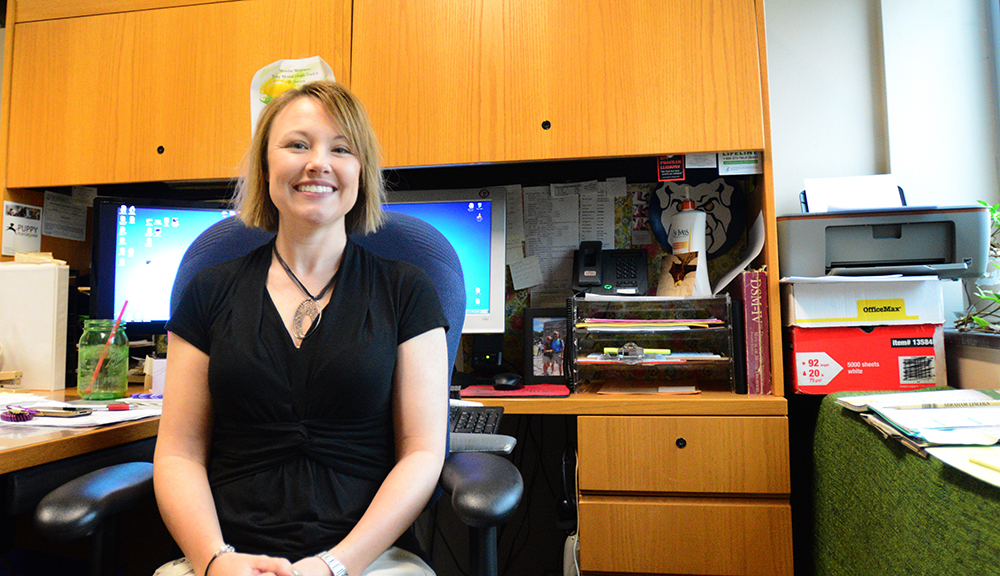Constance Rodenbarger has grappled with mental illness her entire life. In second grade, she was diagnosed with clinical depression.
After years at cosmetology school and community college, Constance was finally on her way to earning a fine arts degree at IU. She was doing it on her own, without counseling or medication.
Then things began to fall apart. She sank deep into depression during the fall 2014 semester. She cut herself. She skipped class. She struggled to sleep or even leave her bedroom. It felt like she was drowning.
“I couldn’t do it on my own anymore,” the 32-year-old said.
So last November, Constance walked into Counseling and Psychological Services. CAPS scheduled her for the first available appointment — two weeks later.
It wasn’t soon enough.
On the night of Nov. 17, 2014, Constance tied a pink scarf to the bedroom door at her off-campus apartment. She put the scarf around her neck, tightened it and tried to kill herself. As she hung, all she could think about was how much it hurt.
Her next memory is of collapsing on the floor and gasping for breath while her roommate called 911. Police and paramedics came, asking questions, as she was loaded into the ambulance. She lay on a stretcher in the back, semi-conscious and nauseous, surrounded by a blur of disconnected voices.
The next day, Constance called CAPS from her hospital bed.
“Hey, I’m not going to make my appointment,” Constance recalled saying. “I’m actually in the hospital from hanging myself.”
***
At colleges across the country, an increasing number of students dealing with serious mental health problems are seeking treatment. Anxiety, suicidal thoughts, depression and diagnoses of eating disorders and alcohol abuse are at an all-time high among college students, according to the American Psychological Association.
IU shares the same concerns. At least four IU students committed suicide during the fall 2014 semester. The number of IU students seeking professional help for personal problems has soared by at least 40 percent in the past decade.
CAPS is the go-to provider for students’ mental health. With 22 counselors and a budget of $2.5 million, CAPS is tasked with addressing the personal problems of the some 4,000 students who flock to it each year.
One out of every 11 students visited CAPS last year. As Constance’s story illustrates, not everyone is happy with CAPS’s ability to respond to growing student need.
CAPS struggles with a lack of staffing, a restricted budget and a perception that they are not nimble enough to provide what students need, when they need it.
Officials insist they are doing what they can. CAPS offers a crisis hotline and walk-in emergency services.
In January, CAPS responded to students’ concerns about long wait times with a new program. Through CAPS-Now, students are seen within 48 hours for a 30-minute assessment and then schedule a follow-up appointment depending on their situation.
“If they’re suicidal, they’re not just having to wait 2 1/2 weeks,” said CAPS director Nancy Stockton, who said stories like Constance’s — attempting suicide while waiting for an appointment — aren’t common. “It allows us to get them in at the appropriate time.”
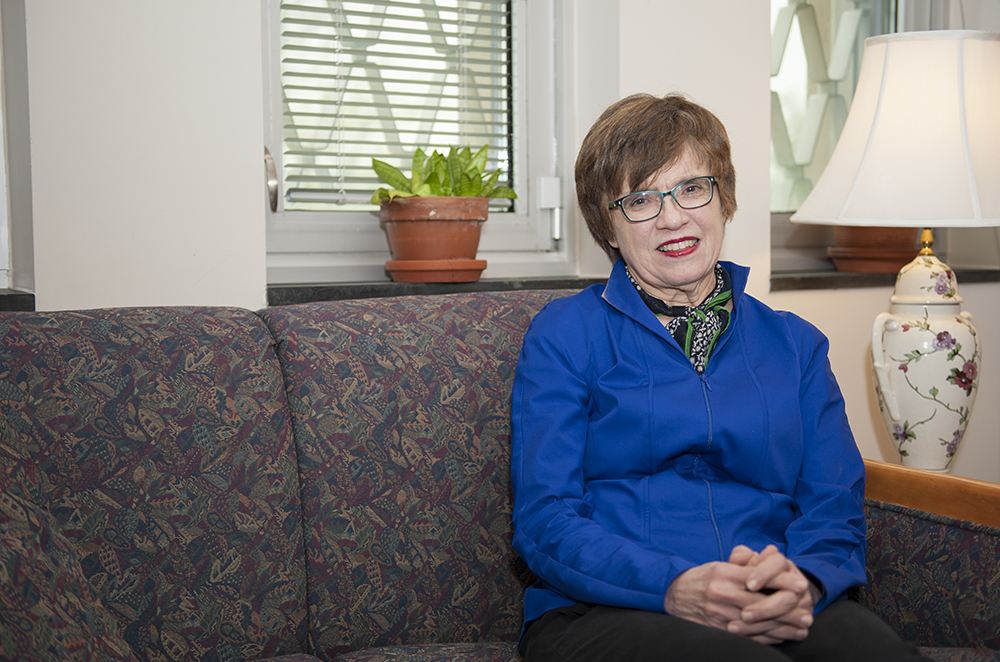 Director of Counseling and Psychological Services (CAPS) Nancy Stockton, Ph.D., has been working closely with IUSA this past semester on a program called CAPS-Now. This program allows students to be seen within 24 hours of contacting CAPS. This program is in response to concerns that wait times for CAPS could stretch for more than two weeks.
Director of Counseling and Psychological Services (CAPS) Nancy Stockton, Ph.D., has been working closely with IUSA this past semester on a program called CAPS-Now. This program allows students to be seen within 24 hours of contacting CAPS. This program is in response to concerns that wait times for CAPS could stretch for more than two weeks.
Since 2005, CAPS added the equivalent of eight full-time counselors and hopes to hire three more next year. But, like many large public universities, IU does not meet nationally recommended numbers. In fact, CAPS would need to hire nine more counselors to meet the minimum ratio suggested by the International Association of Counseling Services, or IACS — one counselor per 1,500 students.
Constance’s initial call left her frustrated she wasn’t seen quickly in her time of crisis.
She argues CAPS should have enough counselors to schedule all appointments with urgency.
“A student approaching someone to say they’re in over their head is not saying ‘I want help,’” she said. “They are saying ‘I want you to help me.’”
A bigger problem
CAPS began in 1978, when the psychiatric division of the IU Health Center merged with IU’s counseling center at the corner of Seventh Street and Jordan Avenue. At the time, eight counselors saw students.
CAPS has grown steadily since and now occupies 13,000 square feet on the fourth floor of the Health Center.
The number of counselors has grown, too — but some say not by enough.
CAPS, like similar programs at other universities, has been admonished for lack of personnel by IACS, an accreditation body for college counseling services.
IACS recommends at least 31 counselors for IU’s current student population, but the center has only 22.
In a 2011 letter evaluating CAPS, the organization wrote it was concerned about the staff-to-student ratio, which was “far outside” the IACS recommendation. The concern had been noted in IACS reviews repeatedly since 1998.
Stockton suggested the IACS target ratio was not realistic, calling it “very idealized,” and she pointed out that IACS still accredits IU’s counseling services and gives positive feedback. CAPS argues the number of counselors does not have a negative effect on services. IACS noted in its last evaluation that staffing had improved.
However, Health Center Director Pete Grogg said he started questioning the number of counselors when CAPS’s wait times were more than two weeks.
 Pete Grogg, MHA, the Executive Director of the IU health Center, has been working closely with IUSA this past semester on a program called CAPS-Now. This program allows students to be seen within 24 hours of contacting CAPS. This program is in response to concerns that wait times for CAPS could stretch for more than two weeks.
Pete Grogg, MHA, the Executive Director of the IU health Center, has been working closely with IUSA this past semester on a program called CAPS-Now. This program allows students to be seen within 24 hours of contacting CAPS. This program is in response to concerns that wait times for CAPS could stretch for more than two weeks.
“The wait time for a new appointment, two to three weeks, was dangerously high,” Grogg said. CAPS started looking at triage systems in the fall. “When a student finally reaches out and they want help, they don’t want to be told that they have to wait,” Grogg said.
One reason IACS certifies IU, despite it’s counselor number, is because CAPS offers group sessions, which may counsel five to 10 students.
Groups provide a community of people dealing with the same problems while allowing more students to receive counseling.
Even with group sessions, CAPS counselors are busy, said Chris Meno, a counselor and coordinator of CAPS outreach. Counselors are never sitting around twiddling their thumbs, she said. In addition to a 40-hour workweek, counselors often work nights and weekends on side projects.
Meno said every person in the Health Center would welcome more staff.
“The more people, the better to help when it comes to mental health,” Meno said. “Every university would say yes, they want more counselors.”
Northwestern University and Rutgers University were the only schools in the Big Ten that met the IACS minimum suggested ratio in 2014, according to Indiana Daily Student calculations evaluating the number of counselors and the size of the student population.
Small, private schools are more likely to meet that ratio, Micky Sharma said, head of Ohio State University’s counseling and consultation services. Ohio State, the largest school in the Big Ten, does not meet the ratio, either, and is applying for IACS accreditation regardless.
Part of the problem is there is no official accrediting body mandating a certain counselor to student ratio at every school, explained Dr. Morton Silverman, a senior advisor to the Suicide Prevention Resource Center. IACS is just one of several groups.
Rather, these standards are determined by the center itself.
“Depending on where the funding comes from and how it is dispersed often dictates how large of a staff you have, how available you are in terms of hours, etc.,” he said.“What is the ideal? I don’t know.”
Money matters
CAPS is funded entirely by students.
“Every dollar we spend is your dollar,” Grogg said.
CAPS is a division of the Health Center, and it actually loses money each year. It’s able to run because other areas of the Health Center make up the difference.
So in theory, the more students that buy a flu shot, the more money available for students with mental health problems.
Students who pay the health fee have two free counseling sessions per semester. The CAPS-Now visit counts as one. Each additional 50-minute counseling session is $20.
“If you know anything about therapy rates in the area, that is ludicrously low,” Stockton said.
According to the Centers for Medicare and Medicaid Services, a “reasonable” charge for a 45- to 50-minute counseling session is $65-$114.
For the first time in a decade, CAPS charges will increase.
The trustees will decide the university budget, including CAPS's, in May. CAPS wants to increase psychological counseling sessions by $5 and psychiatric visits by $10. The budget also proposes increasing the student health fee by 2 percent, the maximum increase the Health Center can request.
In order to hire more counselors, CAPS petitions the Health Center and then the Dean of Students for a change to the budget. They have to demonstrate a reason for their need.
Student group representatives say CAPS is constricted by the funding it can receive.
“A lot of times it will be difficult to have a CAPS representative say we need more of this,” Andrew Braden said, IU Student Association president who helped develop CAPS-Now.
 Andrew Braden, IU Student Association, sits in his office and talks about how Counseling and Psychological Services (CAPS) has made it possible for students to get counseling help in 48 hours.
Andrew Braden, IU Student Association, sits in his office and talks about how Counseling and Psychological Services (CAPS) has made it possible for students to get counseling help in 48 hours.
When CAPS-Now began in the middle of the academic year, two part-time counselors were hired to handle about half the sessions. In general, however, CAPS adjusts its number of staff when planning its budget every two years.
More and more of the Health Center’s money has been allotted to mental health in recent years. During the past decade, the CAPS budget has grown by more than $1 million.
The draft of the 2015-16 budget proposes hiring two full-time counselors for the CAPS-Now program and one full time counselor to create and lead a telecounseling program, offering counseling through Internet video calls.
But could they use more counselors and funding?
“Of course we could use more resources,” Stockton said.
Student perception
Sophomore Rebekah Eichberg said she is happy with the quality of her counseling sessions but admits scheduling can be tricky.
 Sophomore Rebekah Eichberg, vice president of development and education for Culture of Care, was happy with her counseling experience. Ye Wang / IDS.
Sophomore Rebekah Eichberg, vice president of development and education for Culture of Care, was happy with her counseling experience. Ye Wang / IDS.
Eichberg is the vice president of development and education for Culture of Care, a campus-wide movement calling for IU students to support their peers. She tries to see a CAPS counselor every week to help manage her anxiety.
“Obviously, not every week I can get an appointment,” Eichberg said. “That’s where it gets a little complicated. We’ll try to book two weeks out and get appointments, but they are not always available.”
The only way to attend CAPS counseling more frequently, sophomore Leann Freudinger said, was to continually switch counselors.
 Leann Freudinger, a member of IU's chapter of To Write Love on Her Arms, had a satisfactory experience with CAPS counseling. Ye Wang / IDS
Leann Freudinger, a member of IU's chapter of To Write Love on Her Arms, had a satisfactory experience with CAPS counseling. Ye Wang / IDS
“It wasn’t as often as I’d like it to be,” she said. “I kind of struggled with that, having to wait to see my counselor. She knew everything about me. I didn’t want to switch counselors just because I wanted to see someone.”
For some students, CAPS isn’t worth the wait.
Cassandra O’Hara, a senior and president of the IU chapter ofActive Minds, tried CAPS counseling her freshman year. If CAPS appointments hadn’t been so difficult to schedule, she probably would have continued to use on-campus therapy, she said.
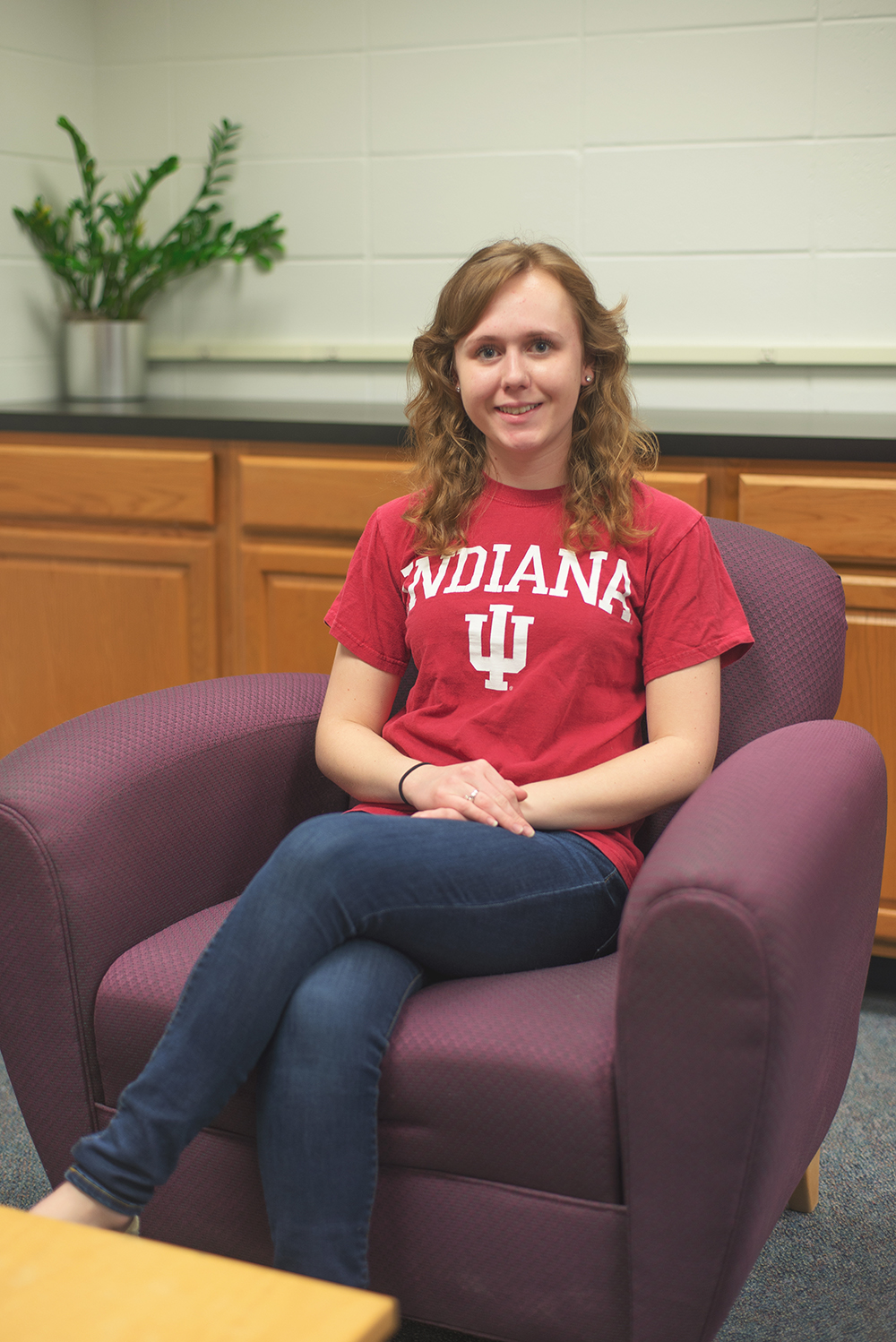 Leann Freudinger, a member of IU's chapter of To Write Love on Her Arms, had a satisfactory experience with CAPS counseling. Ye Wang / IDS
Leann Freudinger, a member of IU's chapter of To Write Love on Her Arms, had a satisfactory experience with CAPS counseling. Ye Wang / IDS
Instead, after taking a semester off and attending counseling sessions in her hometown, O’Hara went to a Bloomington counselor when she returned to IU.
“CAPS needs to expand and hire more therapists in order to be of real benefit to students who actually need to be seeing a therapist on a weekly basis,” O’Hara said.
O’Hara isn’t alone.
In an IUSA survey last fall asking about CAPS, the 868 students who responded said availability is the biggest problem.
Though it does not solve the long-term problem of regular counseling, CAPS-Now helps alleviate the initial issue of being seen. The idea came out of collaboration between IUSA and the Health Center.
The student government wanted to emphasize mental health, but it wasn’t sure where to begin. They asked CAPS what areas could be improved.
“We wanted to make sure students were getting seen,” Braden said. “The wait time for students could be up to two or three weeks. Generally, it’s just a few days, but there’s those peak periods when things spike.
“I think it was a result of us saying we think this is a problem and them saying, ‘Yeah it is.’”
The IUSA survey asked how useful a program with same-day, 30-minute appointments — the idea behind CAPS-Now — would be for students. More than 97 percent responded positively.
Constance said being seen sooner when she asked for help would at least have made her feel less alone in her depression.
Still, she hopes her peers won’t hesitate to ask CAPS for help, despite her initial negative experience. Mental health is simply health, she said.
“I think we can get past the point where we feel ashamed and embarrassed,” she said. “I can’t tell you how many times I’ve seen a classmate on my way out from a session. They’re there in CAPS, too.”
Growing
The CAPS-Now program has clearly tapped into a need among students, drawing 847 patients in the first three months — more than 17 a day.
The more students coming in, the more counselors CAPS needs to have, Grogg said.
With the CAPS-Now program, the number of visits increased by 28 percent compared to the same period last year.
Grogg said he expects that demand to continue.
Hiring three new counselors next year is a start, though it still leaves IU six counselors short of the recommended ratio.
Grogg is full of new ideas to reach students at a different point — before crisis stage.
In the new budget, he suggested hiring “counselors in academic residence” who would work within schools such as the Kelley School of Business or the School of Education to reach students outside of the Health Center.
He also proposed a telecounseling program in which students could interact with a counselor online without having to leave their room.
“It breaks down another barrier to access,” he said.
If demand for counseling continues to rise, Grogg said he is considering turning the third floor of the Health Center into an immediate care clinic for CAPS. Long-term sessions would still be located on the fourth floor.
“Those are all kinds of things we are looking at,” Grogg said, “How can we improve access, how can we make it as easy as possible and quick as possible when a patient determines they need it?”
Of course, CAPS is limited by its budget.
Constance is finishing another year at IU before applying to a masters program for archival sciences, photographic preservation and collections management. She said she hopes to work for the National Aeronautics and Space Administration or maybe the Smithsonian in archival collection.
Her hospital discharge form after her suicide attempt includes thoughts to keep in mind if she feels suicidal again. One line reads: “The one thing that is most important to me and worth living for: to go to the moon.”
A step-by-step action plan is also included on the form. Calling 911 is No.1 on the list. Contacting CAPS is No. 2.
Constance’s initial return to class was jarring. For a week and a half, internal bruising in her throat made swallowing painful. She still feels panicky wearing a scarf or pulling her hoodie strings too tight.
But she’s excited for this fall, when she moves into a new place and focuses on finishing school. CAPS is helping her set up an appointment with a psychiatrist who can prescribe medication.
“Thankfully, CAPS became an option for me while I was in the hospital,” she said.
“Once I got in, I’m in.”

